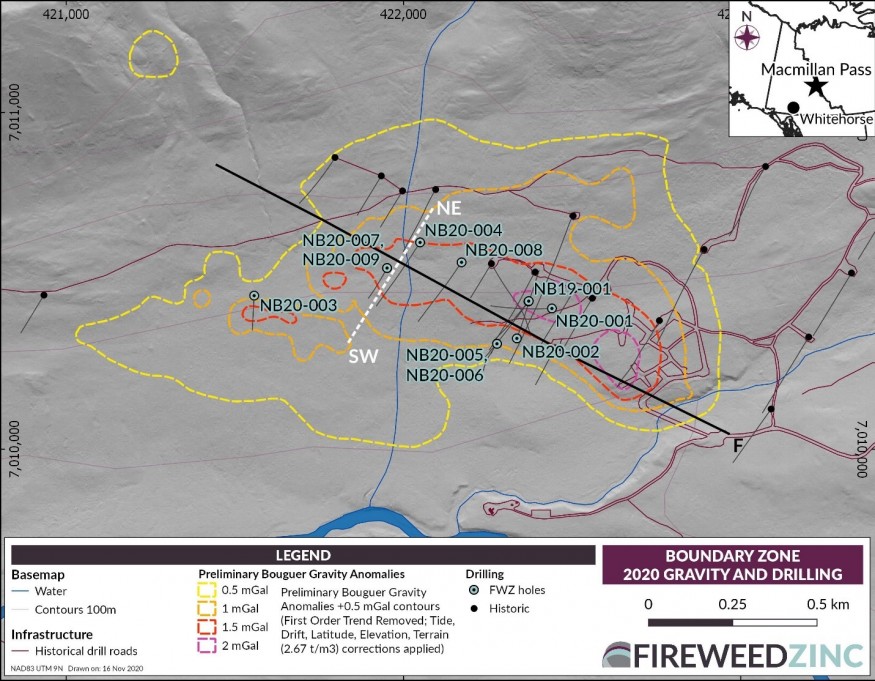VANCOUVER, British Columbia, Nov. 24, 2020 (GLOBE NEWSWIRE) — FIREWEED ZINC LTD. (“Fireweed” or the “Company”) (TSXV: FWZ) announces that as a result of the most recent drill results discovering new mineralized zones at Boundary, the Company has expanded the search area with strong discovery potential.
Two distinct systems were drilled at the new discovery at Boundary West: an upper sequence and a lower sequence of stratiform zinc mineralization. These stratiform systems are overprinted by wide intervals of vein-hosted mineralization. Historic exploration focused only on the upper sequence rock units. The discovery of zinc mineralization in the lower sequence rocks, in addition to the surrounding wide intervals of vein mineralization, greatly expand the search area with strong discovery potential.
The upper sequence includes a stratiform, massive-sulphide cap to the system hosted by mid-late Devonian rocks; and a lower sequence of stratiform zinc mineralization hosted in Late Ordovician-Early Silurian rocks. The discovery of Boundary West was originally announced in Fireweed news release dated 24th September 2020.
Highlights
- 25.6 metres of massive-sulphide pyrite-sphalerite-galena mineralization were intersected by hole NB20-004 in a barite rich section that may represent a replaced barite cap to the system.
- Laminated barite-replacement zinc-lead mineralization similar in style to Tom and Jason were intersected in holes NB20-007 and NB20-009.
- Significant widths of stratiform zinc mineralization have been intersected in NB20-009 within the same age host rocks as those that host mineralization in the Howard’s Pass district, representing the first discovery of this style of mineralization in the Macmillan Pass district.
CEO Statement
Brandon Macdonald, CEO, stated, “Boundary West is open in all directions and even though we are at the initial stages of discovery, the early indications of multiple styles of mineralization across wide intervals point to the potential for a very large deposit at Boundary Zone. Adding to this potential is what we are learning from the geology at the new discovery. Historically, exploration in the district focused on the upper sequence Devonian age rocks where the Tom and Jason stratiform deposits are situated. This new discovery clearly demonstrates that the lower sequence Ordovician-Silurian age rocks are also host to significant stratiform zinc mineralization. This along with the wide zones of vein mineralization at Boundary West indicate great potential throughout the property for additional discoveries in lower sequence rocks that have seen little exploration effort in the past.”
Boundary West
The new discovery at Boundary West was made by drill testing a large gravity anomaly detected in August 2020 (see Map 1). Zinc mineralization at Boundary West is present in two sequences: the upper sequence; and the lower sequence. Each sequence broadly comprises an interval of stratiform zinc mineralization overprinted and underlain by an interval of vein-hosted zinc mineralization (see Table 1 and Cross section 1).
Upper sequence
The first drillhole into the gravity anomaly, NB20-004, intersected 25.6 metres of massive-sulphide mineralization from 130.6 m to 156.2 m, comprising mostly massive pyrite (>80% vol.) with some sphalerite and minor galena. Relict patches of black mudstone and mudstone fragments containing barite pseudomorphed by silica or pyrite are found within the massive-sulphide. This intersection is in the stratigraphy above Boundary Zone in rocks that are correlative with the host rocks to the Tom and Jason deposits. In subsequent drillholes NB20-007 and NB20-009, laminated sphalerite-galena-pyrite mineralization (similar in style to Tom and Jason) and semi-massive sulphides were intersected at the same stratigraphic interval as the massive-sulphide in NB20-004. Overprinting and underlying the stratiform interval, wide intervals of vein hosted pyrite-sphalerite mineralization were intersected: e.g. NB20-004 intersected 76.8 m of vein hosted and semi-massive pyrite-sphalerite mineralization below the massive-sulphide from 156.2 to 233.0 m (see Cross Section 1).
Dr. Jack Milton, Fireweed Chief Geologist, commented, “The upper interval in NB20-004 appears to represent a massive–sulphide cap to the system and the textures suggest that this layer may have originally been barite-rich and has been subsequently replaced by sulphide. There are strong textural parallels with other sediment-hosted massive–sulphide systems such as Red Dog, Alaska, and further parallels with the spatial relationship between the massive–sulphide and the underlying vein-hosted mineralization. This gives a compelling reason to step out the drilling next season and attempt to vector towards more feeder-proximal parts of the system where there is the potential for higher grade sections of massive–sulphide.”
Lower sequence
Stratiform zinc mineralization was intersected in hole NB20-009 from 160.0 m to 227.8 m (67.8 m intersected), occurring as fine to medium grains of disseminated grey sphalerite concentrated along sedimentary laminae in radiolarian cherty mudstones. Identification of graptolite fossils that precisely date the rocks from the new discovery west of Boundary Zone show that stratiform sphalerite mineralization occurs in the late Ordovician-Early Silurian part of the Road River Group (Cross Section 1). This demonstrates that stratiform mineralization in NB20-009 occurs not only in the upper sequence mid to late Devonian Earn Group rocks that host mineralization at Tom and Jason but that a second wide mineralized interval occurs in the older, lower sequence Late Ordovician-Early Silurian rocks.
Dr. Jack Milton commented, “The discovery of stratiform sphalerite mineralization in these lower sequence Late Ordovician to Early Silurian rocks at Boundary West is highly significant as Early Silurian rocks host the large zinc-lead deposits at Howard’s Pass, 90 km southeast of our property, and this is the first discovery of stratiform mineralization hosted in Early Silurian rocks in the Macmillan Pass district. This discovery shows the existence of multiple pulses of mineralization and a long-lived hydrothermal system that is hosted by rocks of at least Upper Ordovician to late Devonian age. The new discovery at Boundary West demonstrates that not only does the Macmillan Pass district have potential to contain upper sequence mid-late Devonian hosted deposits; but also, lower sequence Howard’s Pass style Early Silurian hosted zinc-lead deposits.”
The lower sequence stratiform interval of zinc mineralization is overprinted by multiple generations of sphalerite-pyrite-quartz-galena-siderite veins. The vein mineralization forms a wide interval, overlapping the stratiform mineralization and extending 178.2 m below the stratiform styles of mineralization in NB20-009 from 227.8 m to 406.0 m (see Cross Section 1 and Fireweed news releases dated September 24th, 2020 and October 15th, 2020 for details). Hole NB20-004 was terminated before reaching lower sequence rocks.
The gravity anomaly at Boundary West remains untested along strike for hundreds of metres in both directions away from the fence of discovery drill holes.
Assays remain pending for all 2020 drilling at Boundary Zone and no visual estimates for grade are reported. All drilled intervals are stated as intersected widths, and true widths have not been estimated as NB20-004, NB20-007, and NB20-009 are the first three holes drilled into the exploration target at Boundary West and the three dimensional geometry of the mineralized zone has not been defined. Investors are cautioned that textural comparisons of the mineralization in the Fireweed exploration targets discussed in this news release to other mineralized systems does not imply an expectation for similar grades, volumes or potential for eventual economic extraction.
Qualified Person Statement
Technical information in this news release has been approved by Gilles Dessureau, P.Geo, Vice President Exploration and a ‘Qualified Person’ as defined under Canadian National Instrument 43-101.
About Fireweed Zinc Ltd. (TSXV: FWZ): Fireweed Zinc is a public mineral exploration company focused on zinc-lead-silver and managed by a veteran team of mining industry professionals. The Company is advancing its district-scale 936 km2 Macmillan Pass Project in Yukon, Canada, which is host to the 100% owned Tom and Jason zinc-lead-silver deposits with current Mineral Resources and a PEA economic study (see Fireweed news releases dated January 10, 2018, and May 23, 2018, respectively, and reports filed on www.sedar.com for details) as well as the Boundary Zone, Tom North Zone and End Zone which have significant zinc-lead-silver mineralization drilled but not yet classified as mineral resources. The project also includes large blocks of adjacent claims (MAC, MC, MP, Jerry, BR, NS, Oro, Sol, Ben, Stump) which cover exploration targets in the district where previous and recent work identified zinc, lead and silver prospects, and geophysical and geochemical anomalies in prospective host geology.
Additional information about Fireweed Zinc and its Macmillan Pass Zinc Project including maps and drill sections can be found on the Company’s website at www.FireweedZinc.com and at www.sedar.com.
ON BEHALF OF FIREWEED ZINC LTD.
“Brandon Macdonald”
CEO & Director
Neither the TSX Venture Exchange nor its Regulation Services Provider (as that term is defined in the policies of the TSX Venture Exchange) accepts responsibility for the adequacy or accuracy of this release.
Cautionary Statements
This news release may contain “forward-looking” statements and information relating to the Company and the Macmillan Pass Project that are based on the beliefs of Company management, as well as assumptions made by and information currently available to Company management. Such statements reflect the current risks, uncertainties and assumptions related to certain factors including but not limited to, without limitations, exploration and development risks, expenditure and financing requirements, general economic conditions, changes in financial markets, the effects of the pandemic, the ability to properly and efficiently staff the Company’s operations, the sufficiency of working capital and funding for continued operations, title matters, First Nations relations, operating hazards, political and economic factors, competitive factors, metal prices, relationships with vendors and strategic partners, governmental regulations and oversight, permitting, seasonality and weather, technological change, industry practices, and one-time events. Additional risks are set out in the Company’s prospectus dated May 9, 2017, and filed under the Company’s profile on SEDAR at www.sedar.com. Should any one or more risks or uncertainties materialize or change, or should any underlying assumptions prove incorrect, actual results and forward-looking statements may vary materially from those described herein. The Company does not undertake to update forward‐looking statements or forward‐looking information, except as required by law.


